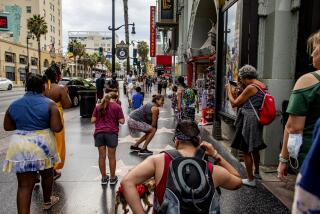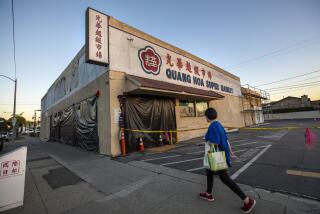Chinese tourists are the export that California is chasing
- Share via
SHANGHAI — Five years after closing its overseas trade bureau here, California launched a new office Wednesday aimed at getting a bigger share of one of China’s biggest exports: tourists.
The California Travel and Tourism Commission has set up shop in three locations in China over the last couple of months, in Beijing and Guangzhou in addition to Shanghai. The Chinese offices will cost $750,000 to operate this year, but California taxpayers won’t be footing the bill. The funds will come entirely from assessments to the state’s tourism industry, said Dale E. Bonner, California’s secretary of Business, Transportation and Housing, who was in Shanghai for the official opening.
“We have to make the investment now to lay the foundation for the [economic] recovery,” he said from inside a yellow-carpeted Shanghai municipal bus, with Mickey Mouse, the Golden Gate Bridge and other California icons painted on the exterior. As part of the marketing campaign, four such California-branded buses will be rolling through the streets of China’s largest city over the next month.
Nearly 46 million Chinese traveled outside of the mainland last year, yet only about half a million of them went to the U.S. The Golden State got the lion’s share, California officials said. They estimated that 275,000 Chinese visited California in 2008, staying an average of three days.
Mainland Chinese tourists still rank far below visitors to California from Britain, Japan and South Korea. But their numbers are growing at a faster pace.
Chinese tour groups only recently started to arrive in the U.S., after Washington and Beijing last year lifted a ban on leisure group travel to America. And in recent months, representatives of U.S. cities and states have been tripping over one another promoting their sites at tourism fairs throughout China.
“The Chinese market represents the greatest potential for outbound tourists,” said Caroline Beteta, chief executive of the California Travel and Tourism Commission, a privately funded nonprofit organization. “This is a growth industry for California,” she said in Shanghai.
California closed a separate trade-promotion office here at the start of 2004, along with 11 other overseas bureaus, because of a $40-billion state budget deficit. Since then, officials have tried to boost California exports to China through targeted trade missions and other efforts.
Given the state’s current budget woes, there’s little chance of reopening any overseas trade offices any time soon. But California officials hope tourism can help pull the state out of recession, with China leading the way. California’s leisure and hospitality industry has fared better than most sectors during the recession.
Still, 2009 is turning out to be a tough year for California’s international tourism business. China’s weakening economy has slowed the number of its travelers who are flying long distances. China Eastern Airlines, the only carrier that flies nonstop from Shanghai to Los Angeles, has cut some flights. U.S. visa approvals, though faster than in the past, still take many Chinese a month or longer.
Then there’s the competition from other American destinations. At an international trade fair in Shanghai late last year, just about every U.S. state, along with scores of hotel resorts and famous attractions, set up booths squeezed one after another inside the exhibition center.
Among them was Minnesota, known to some as the Gopher State.
“It’s not a tough sell, nope, nope,” said Cheryl Offerman, a marketing official with Minnesota’s tourism agency.
What would a Chinese tourist do in Minnesota?
For starters, visit the Mall of America, she said of the giant shopping emporium. Then there’s America’s most famous river.
“Everybody knows the Mississippi River. It begins in Minnesota,” she said.
California doesn’t have to do much selling at all; the state boasts the largest Chinese population in America. Many in China rank the Golden State at the top of their travel wish list. Most everybody here knows about Los Angeles, San Francisco and Hollywood. But costs remain a hurdle, as does familiarity with lesser-known destinations in the state.
The trick is to keep Chinese tourists in California longer than the typical three days, says Beteta of the state’s travel commission. Chinese visitors know San Francisco but not Lake Tahoe, she says; they know Disneyland but don’t connect it to Orange County.
The new tourism offices in China will help fix that, Beteta says.
--
More to Read
Sign up for The Wild
We’ll help you find the best places to hike, bike and run, as well as the perfect silent spots for meditation and yoga.
You may occasionally receive promotional content from the Los Angeles Times.







